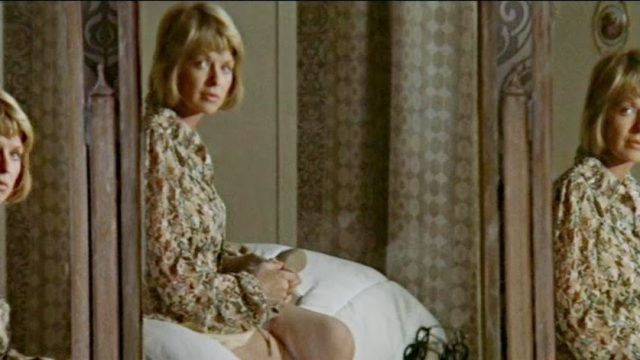Do you see – do you see – do you see how you hurt me baby
So I hurt you too
Then we both get so blue
Images (1972) plays out as if this feeling expressed by the female protagonist of “All I Want”—the opening song off of Joni Mitchell’s introspective masterpiece Blue (1971)—led, not to a hopeful path of self-discovery, but to a downward spiral of psychosis. Robert Altman, the film’s writer and director, must’ve witnessed any number of busted relationships in post-60s Hollywood, but chooses instead the remote setting of a cottage in the misty, faintly-chilled landscape of Ireland.
By the time we realize the strange trip we’re on is taking place inside the head of Cathryn, a British woman under whose reserved demeanor lurks hellishly intense feelings of guilt and anger, it’s too late to turn back, and we’re headed for a closing scene where things go off the rails entirely.
At the start, Cathryn is alone and hears cross-talk on a telephone line: a woman tells Cathryn that Hugh, Cathryn’s husband, is cheating on her. When Hugh arrives to find her in a state, and he tries to reassure her, she sees a very brief glimpse of something that causes her to let out a horrific scream.
The film gains power by initially depicting their troubled relationship in a realistic way—that turns out to be the fantasy of normality that Cathryn desperately clings to. What she’s really experiencing is the trauma of her world splitting apart into fragmented memories.
This dissolution is signaled by the faint peals of wind chimes that echo off into the distance, even while they appear in a close-up shot. Such a motif repeats through the film, a signpost to an altered universe of sights and sounds through which Cathryn drifts.
Camera lenses are strewn about the cottage. Hugh’s a photographer; taking pictures can conjure ghosts. Jacques Derrida has said,
Because we know that, once it has been taken, captured, this image will be reproducible in our absence, because we know this already, we are already haunted by this future, which brings our death. . . We are spectralized by the shot.
Cathryn is visited by the ghost of Rene, a former lover who died a few years ago in a plane crash. He taunts her about Hugh, which reveals her guilt about cheating on her current husband. While he’s rather annoying, showing up seemingly whenever he feels like it, he has a composure that Hugh visibly lacks. To Cathryn’s obvious disdain, Hugh is obsessed, to an almost childish degree, with cameras and guns.
Although it’s easy to glimpse the Freudian overtones here, Altman keeps us off balance by continuously shifting the camera’s perspective, which prevents the film from hardening into a psychoanalytic allegory. What complicates matters is Hugh’s friend, Marcel, who appears both as real and imagined.
And if Marcel can appear in two places at once, so can Cathryn. Altman creates several striking moments where Cathryn appears both in close up in the foreground and a distant figure in the background of a shot. Smart enough not to overdo the effect, Altman gives us an uncanny presentation of the growing distance between Cathryn and her self—or selves—in time and space.
In the proliferation of self-images, Cathryn encounters a youthful double in the form of Susannah, Marcel’s daughter. She may look like an idealized version of Cathryn’s past innocence, but what she thinks and feels indicates what it was like to be a post-60s adolescent. She tells Cathryn that she’s already realized, thanks to her father, that some men cannot, or refuse to be, faithful. Marcel relentlessly pursues Cathryn, regarding his cheating on his friend as a perverse badge of honor.
The three men blur together in Cathryn’s mind; not only does this composite image suggest remarkably little difference in the ways they’ve mistreated her, it also implies that she vacillates between playing the role of victim and villain. Cathryn attempts to find through Susannah a means for self-reconciliation. Not being able to be a younger woman, however, forces her to see herself for who she is: a woman becoming crueler as she passes her peak of beauty and power.
Having acted out the murders of Rene and Marcel—and the look on the face of Susannah York, who plays Cathryn (in a performance that earned her the Cannes Best Actress Award), during these scenes is a wonder to behold—she is pursued by this other woman, the self whom she cannot escape. In desperation she drives away from her; the image of the woman is partial (because it’s a different actor) which gives the impression of how hard Cathryn is trying to erase her from her world. Then she forces her off a cliff and down a waterfall to her demise on the rocks below.
In a classic horror-movie trope, Cathryn takes a shower to wash herself clean, only to be assaulted by the woman. The scene cuts from the shower to the waterfall, the camera showing us that it was Hugh she murdered. And this time, the murder may not have been imagined.
The credits roll over a now-completed puzzle that Cathryn and Susannah were working on in more tranquil moments: a picture of completeness that Cathryn had realized all along was impossible for her to attain. That realization was transformed into violence, once she became unable to balance her desire for love with the trust of a man who could love her. Such feelings of personal suspicion, that poisoned relationships in a post-60s world, found a counterpart in the paranoia of Watergate.
Last year’s entries in this series were Part 7: Werckmeister Harmonies (2000) and Part 8: The Hour of the Wolf (1968).

